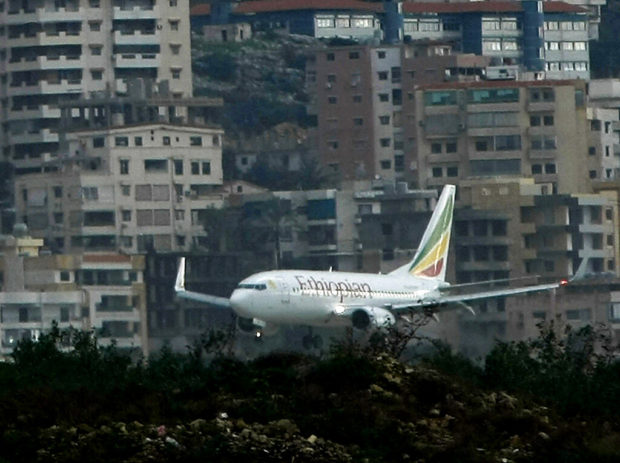157 killed in crash of Ethiopian Airlines flight to Nairobi

In this Jan. 25, 2010, file photo an Ethiopian airplane prepares to land in Beirut International airport hours in Beirut, Lebanon. An Ethiopian Airlines Boeing 737 with 157 people thought to be on board crashed shortly after takeoff Sunday morning, March 10, 2019, from Ethiopia’s capital headed to Nairobi, the airline said. (Photo by BEN CURTIS / AP)
Updated @ 10:48 p.m., March 10, 2019, adding more details and updating count of nationalities on board
ADDIS ABABA, Ethiopia — A jetliner carrying 157 people crashed shortly after takeoff from the Ethiopian capital Sunday, killing everyone aboard, authorities said. More than 30 nationalities were among the dead.
It was not clear what caused the plane to go down in clear weather. The pilot sent out a distress call and was given clearance to return to the airport, the airline’s CEO told reporters.
The Boeing 737-8 MAX operated by Ethiopian Airlines was the same model as a Lion Air jet that plunged into the Java Sea in October just minutes after taking off from Jakarta, Indonesia’s capital. That crash killed 189 people.
The Lion Air cockpit data recorder showed that the jet’s airspeed indicator had malfunctioned on its last four flights, though the airline initially said problems with the aircraft had been fixed.
Article continues after this advertisementThe Ethiopian plane was new, having been delivered to the airline in November. It was on a flight from Addis Ababa to the Kenyan capital of Nairobi. Grieving families rushed to airports in both cities.
Article continues after this advertisementState-owned Ethiopian Airlines is widely considered the best-managed airline in Africa and calls itself Africa’s largest carrier. It has ambitions of becoming the gateway to the continent and is known as an early buyer of new aircraft.
“Ethiopian Airlines is one of the safest airlines in the world. At this stage we cannot rule out anything,” CEO Tewolde Gebremariam said.
The airline said 149 passengers and eight crew members were thought to be on the plane.
Earlier, state broadcaster EBC reported that 33 nationalities were among the victims. A new list shows 35 nationalities among the dead.
Five Germans were killed and three each from Russia, Austria, and Sweden.
Spain, Israel Morocco and Poland each lost two citizens.
Countries losing one citizen were Belgium, Djibouti, Indonesia, Ireland, Mozambique, Norway, Rwanda, Saudi Arabia, Sudan, Somalia, Serbia, Togo, Uganda, Yemen, Nepal, and Nigeria.
The plane crashed six minutes after departing, plowing into the ground at Hejere near Bishoftu, or Debre Zeit, some 50 kilometers (31 miles) south of Addis Ababa, at 8:44 a.m.
Read: Timeline of the deadly Ethiopian Airlines crash
The jetliner showed unstable vertical speed after takeoff, air traffic monitor Flightradar 24 said in a Twitter post.
The airline later published a photo showing its CEO standing in the wreckage. Little of the plane could be seen in the freshly churned earth, under a blue sky.
The Addis Ababa-Nairobi route links East Africa’s two largest economic powers and is popular with tourists making their way to safaris and other destinations. Sunburned travelers and tour groups crowd the Addis Ababa airport’s waiting areas, along with businessmen from China and elsewhere.
Worried families gathered at the airport in Nairobi.
“I came to the airport to receive my brother, but I have been told there is a problem,” Agnes Muilu said. “I just pray that he is safe or he was not on it.”
“Why are they taking us round and round. It is all over the news that the plane crashed,” said Edwin Ong’undi, who was waiting for his sister. “All we are asking for is information to know about their fate.”
The jet’s last maintenance was on Feb. 4, and it had flown just 1,200 hours. The pilot was a senior aviator, joining the airline in 2010, he said.
The Boeing 737-8 MAX was one of 30 being delivered to the airline, Boeing said in a statement in July when the first was delivered.
Boeing said a technical team was ready to provide assistance at the request of the U.S. National Transportation Safety Board.
The last deadly crash of an Ethiopian Airlines passenger flight was in 2010, when a plane went down minutes after takeoff from Beirut, killing all 90 people on board.
African air travel, long troubled and chaotic, has improved in recent years, with the International Air Transport Association in November noting “two years free of any fatalities on any aircraft type.”
Sunday’s crash comes as Ethiopia’s reformist prime minister, Abiy Ahmed, has vowed to open up the airline and other sectors to foreign investment in a major transformation of the state-centered economy.
Ethiopian Airlines’ expansion has included the recent opening of a route to Moscow and the inauguration in January of a new passenger terminal in Addis Ababa to triple capacity.
Speaking at the inauguration, the prime minister challenged the airline to build a new “Airport City” terminal in Bishoftu — where Sunday’s crash occurred. /je /atm